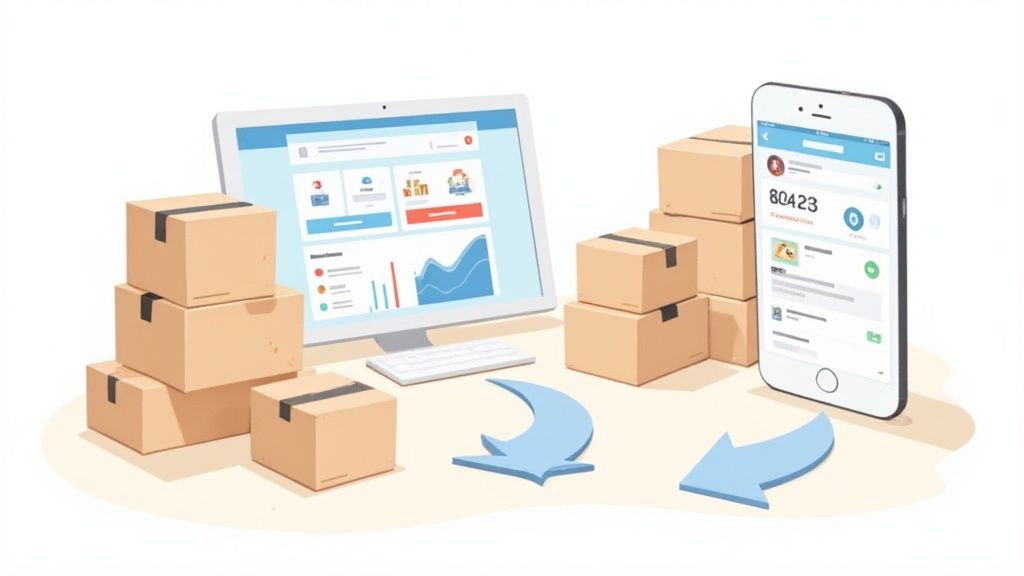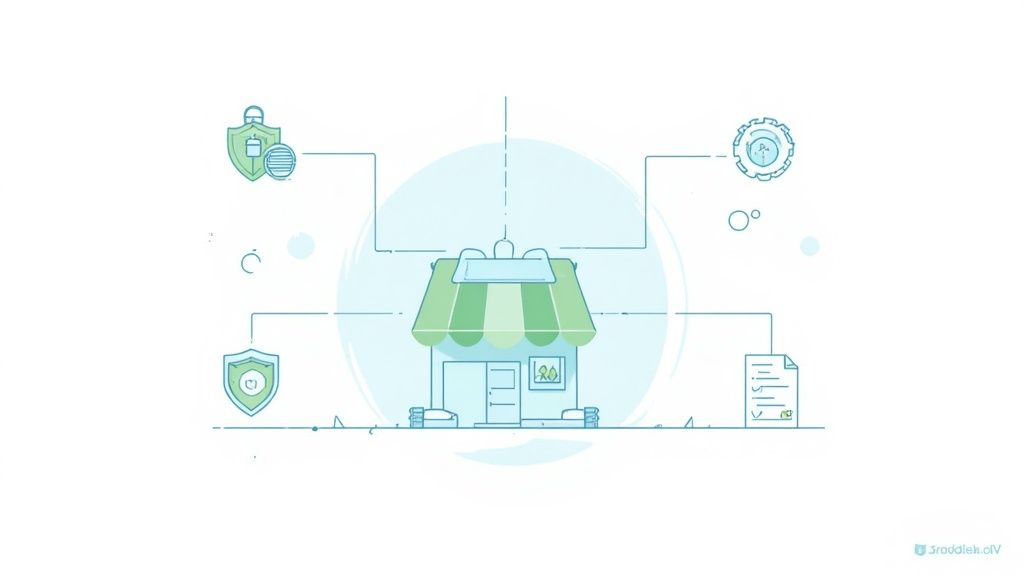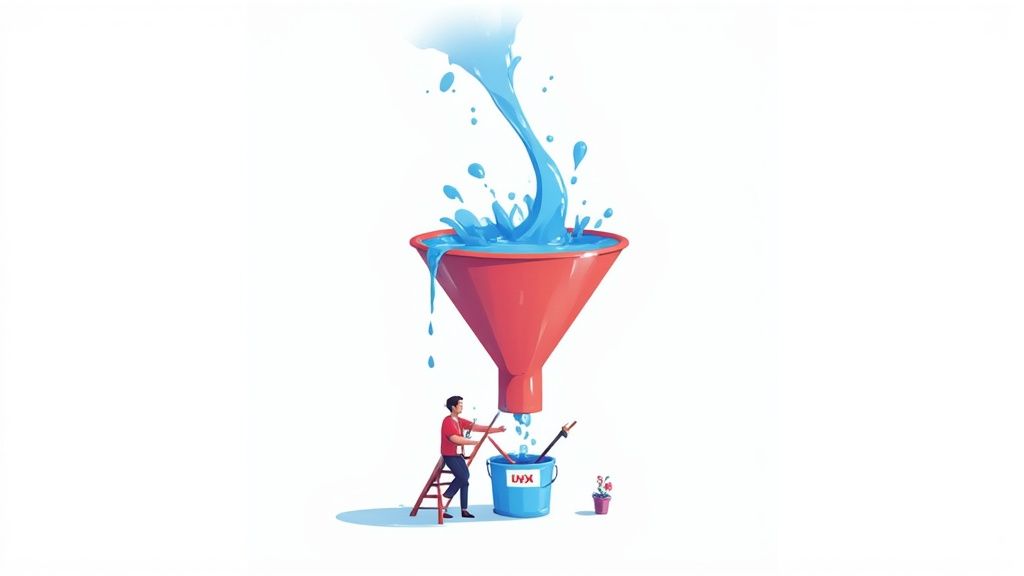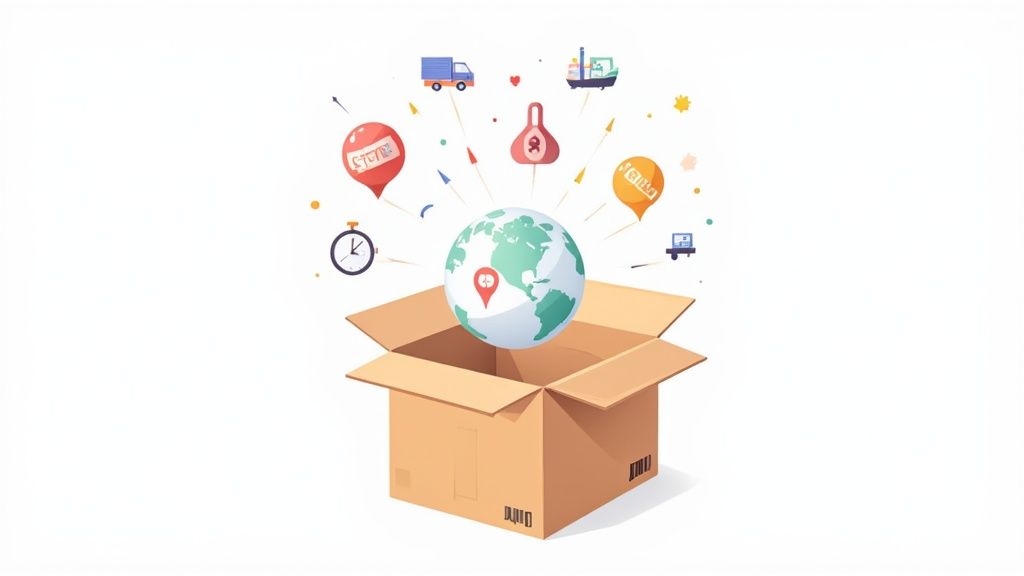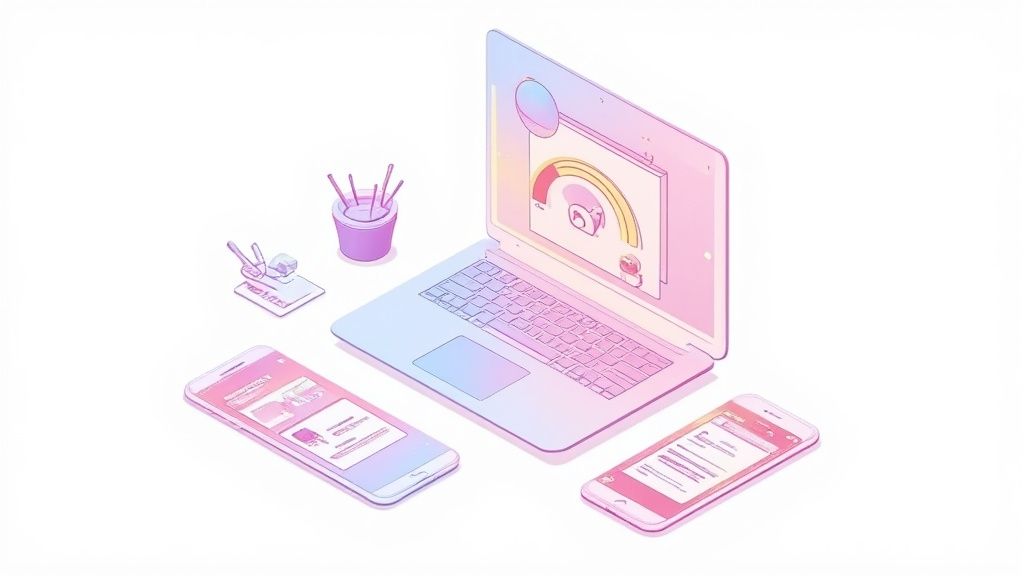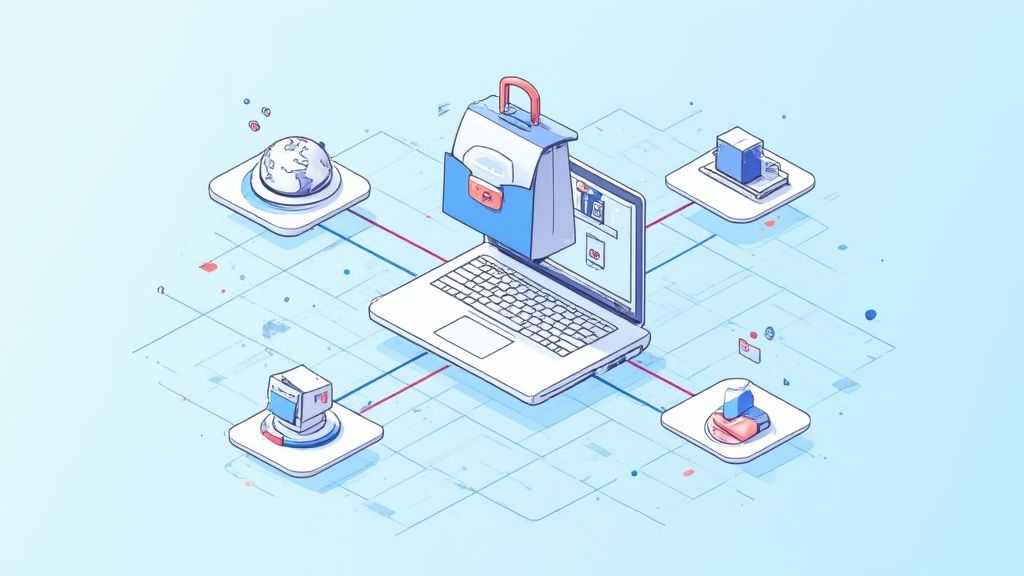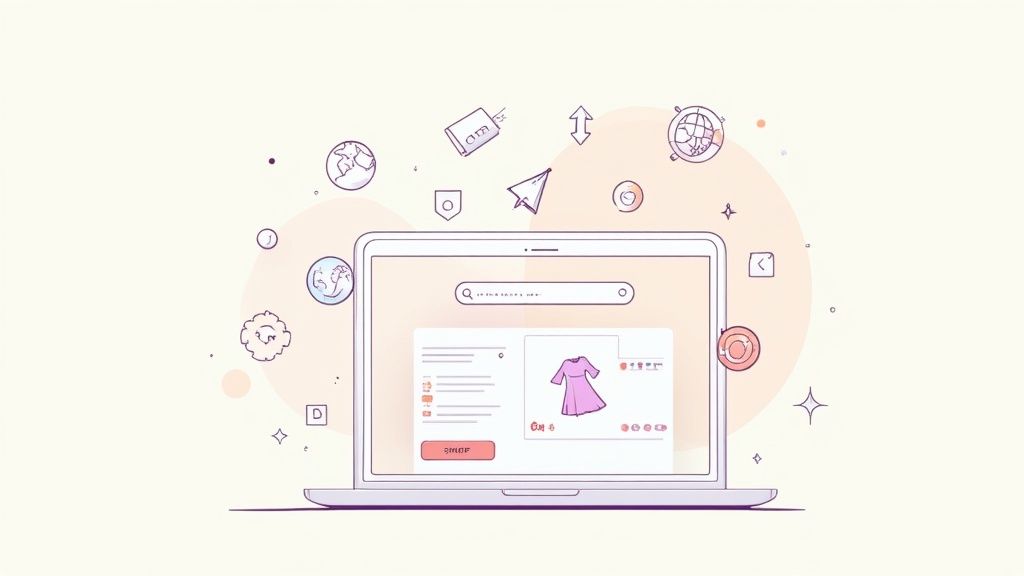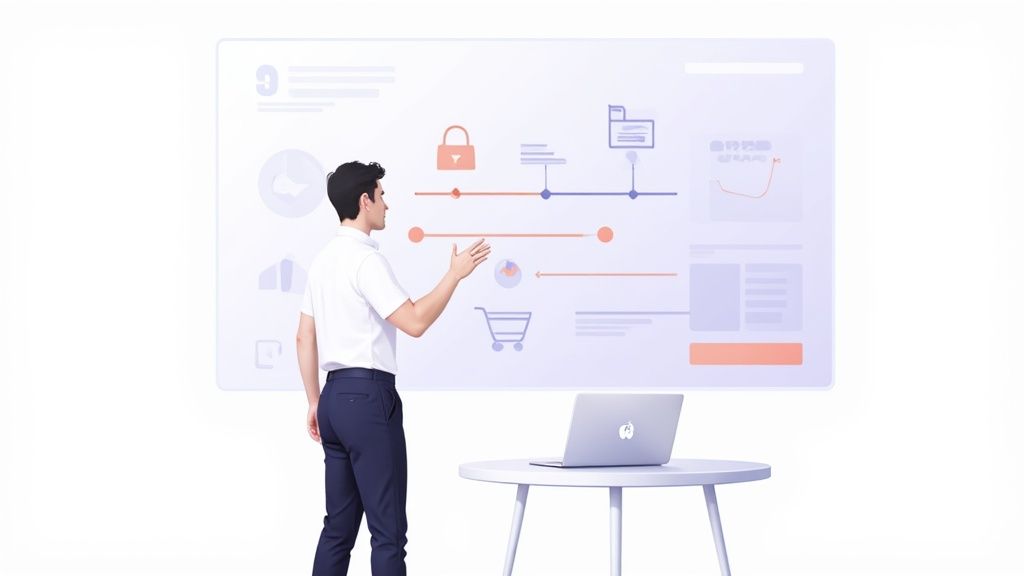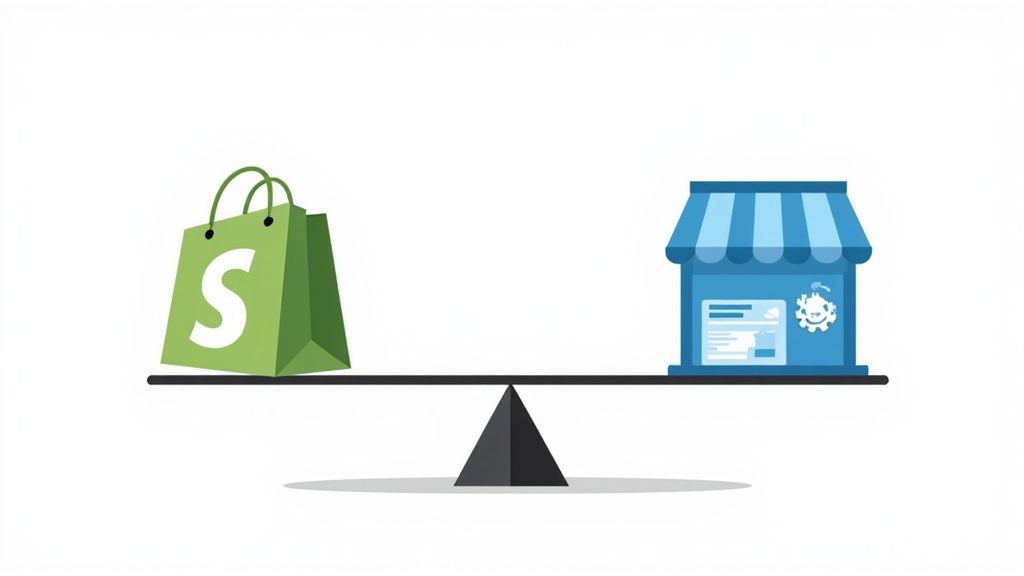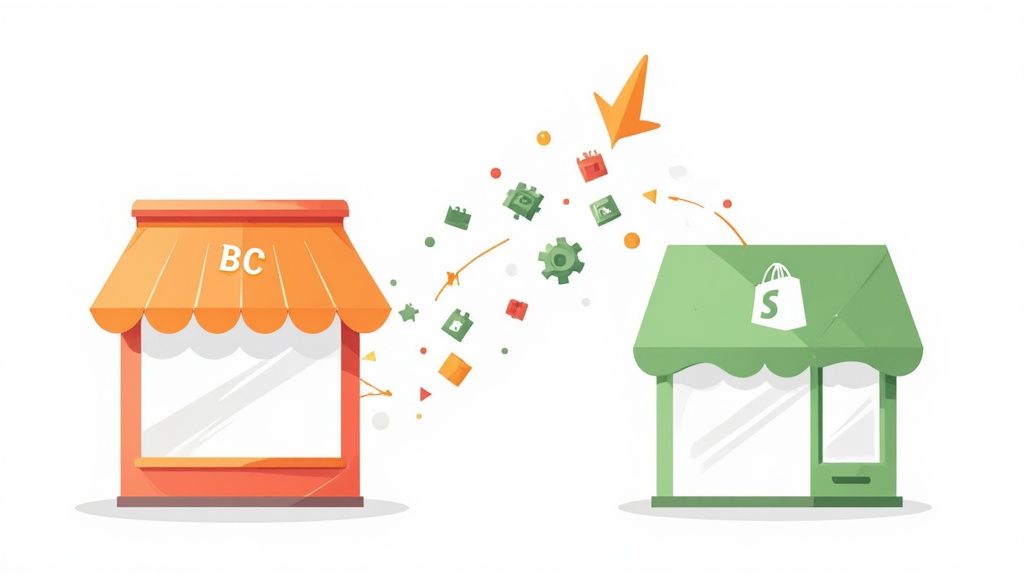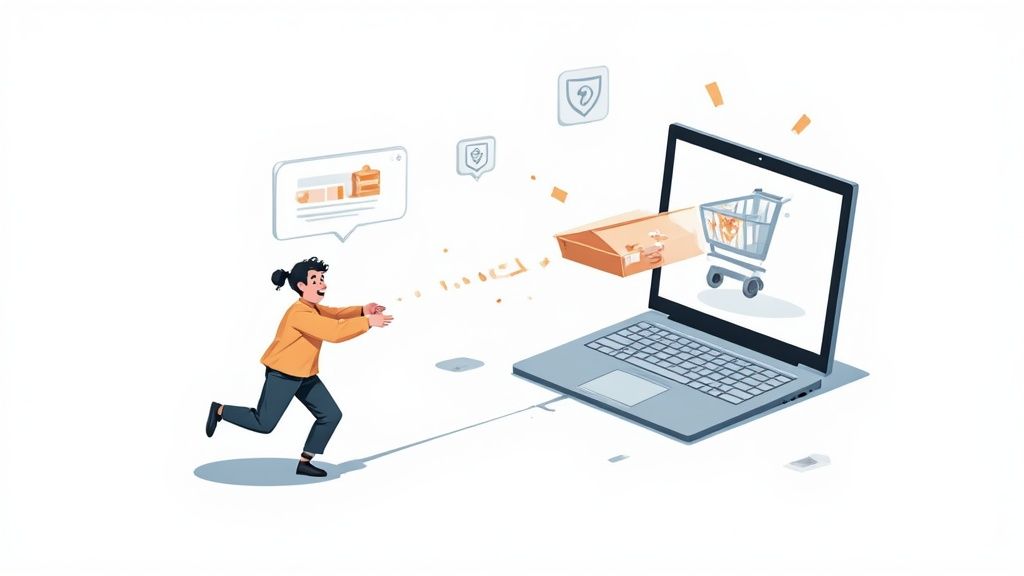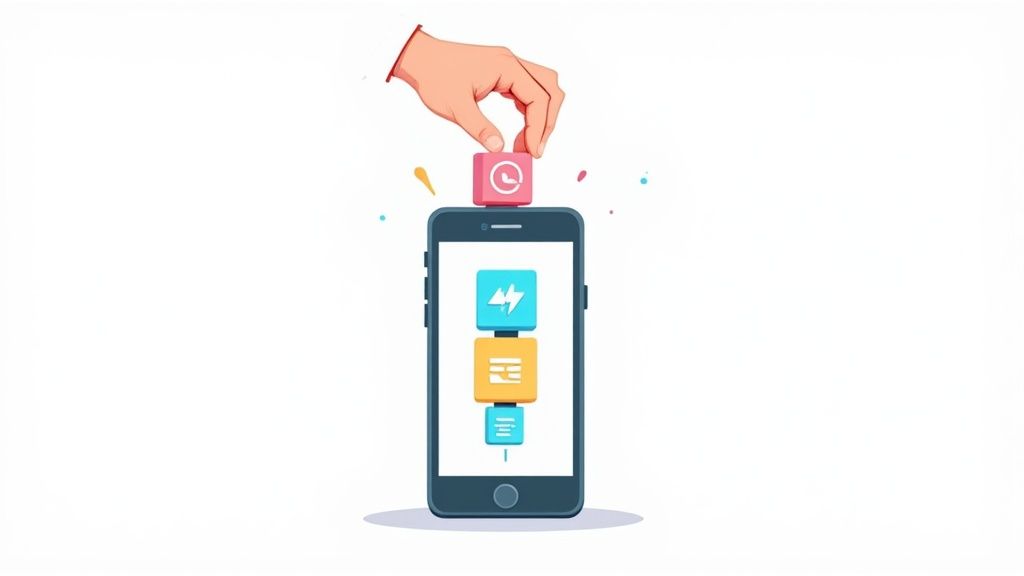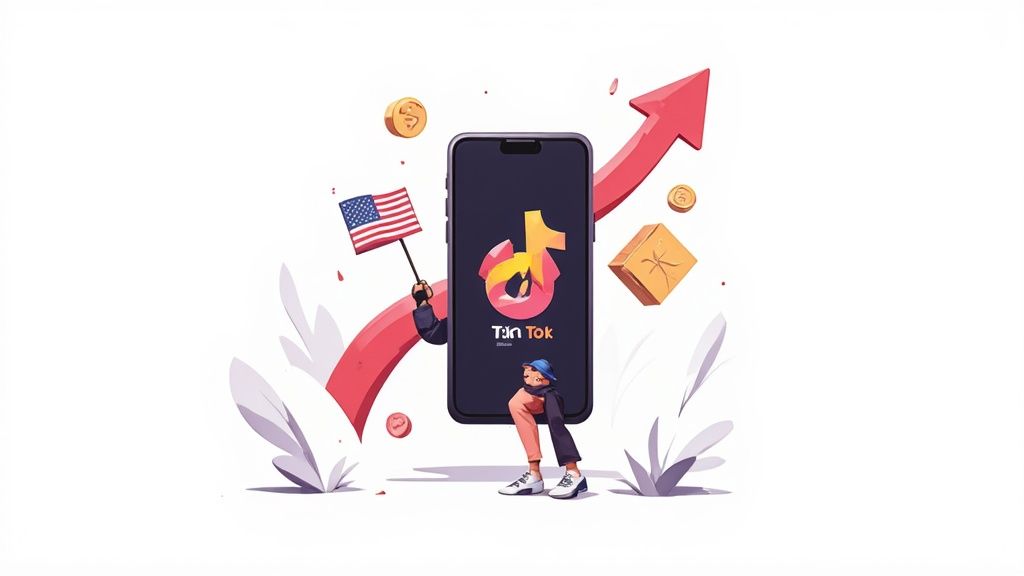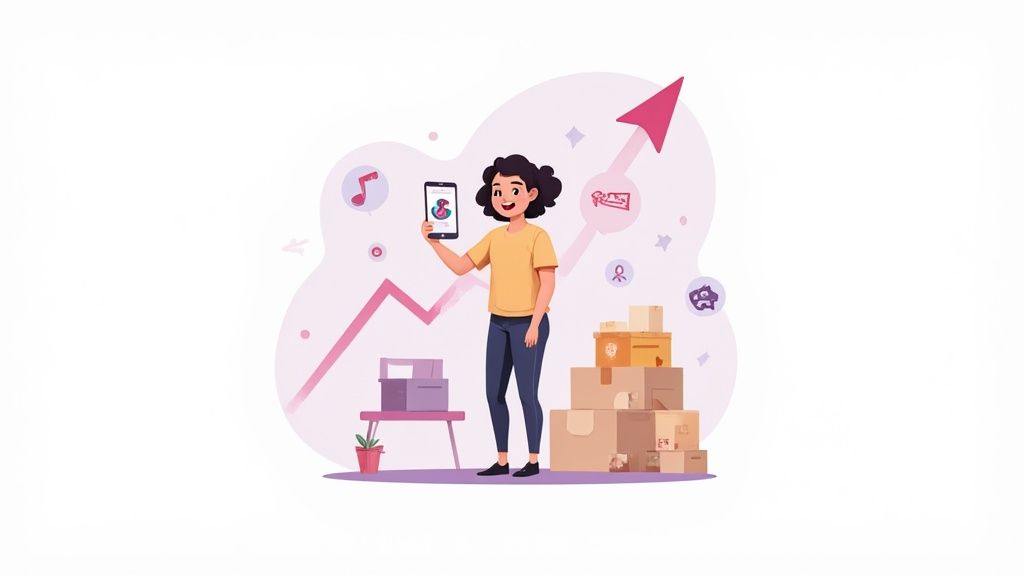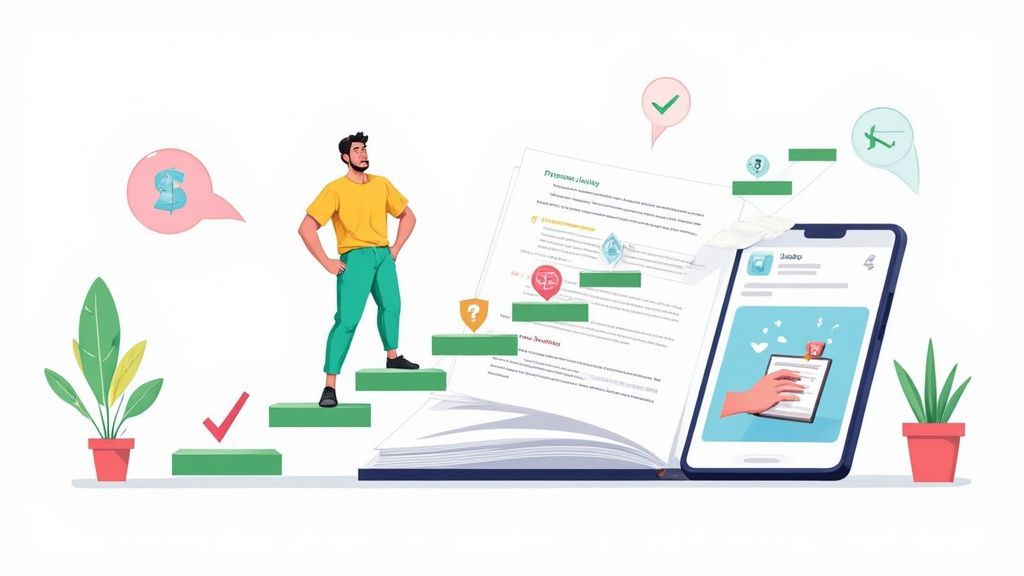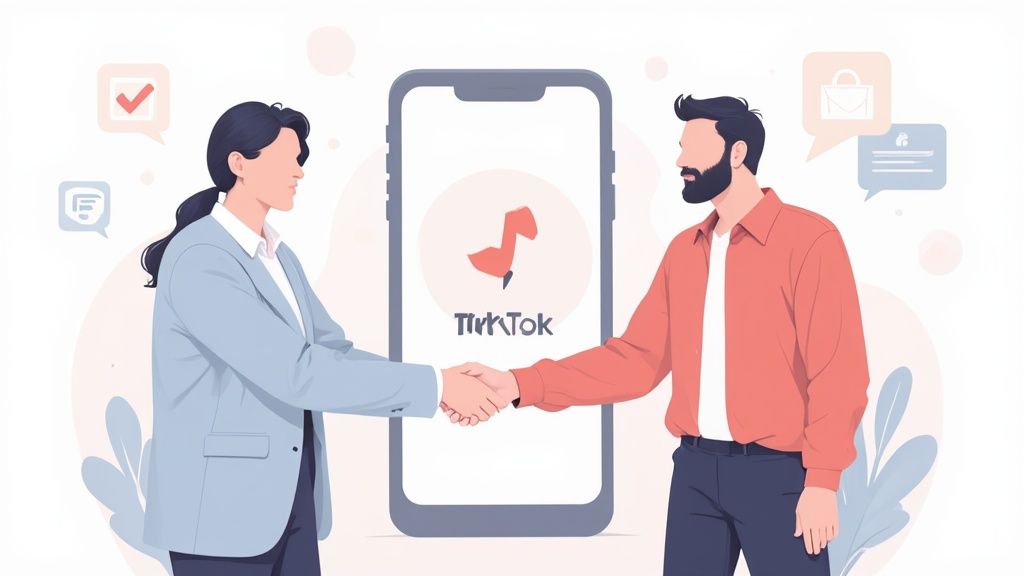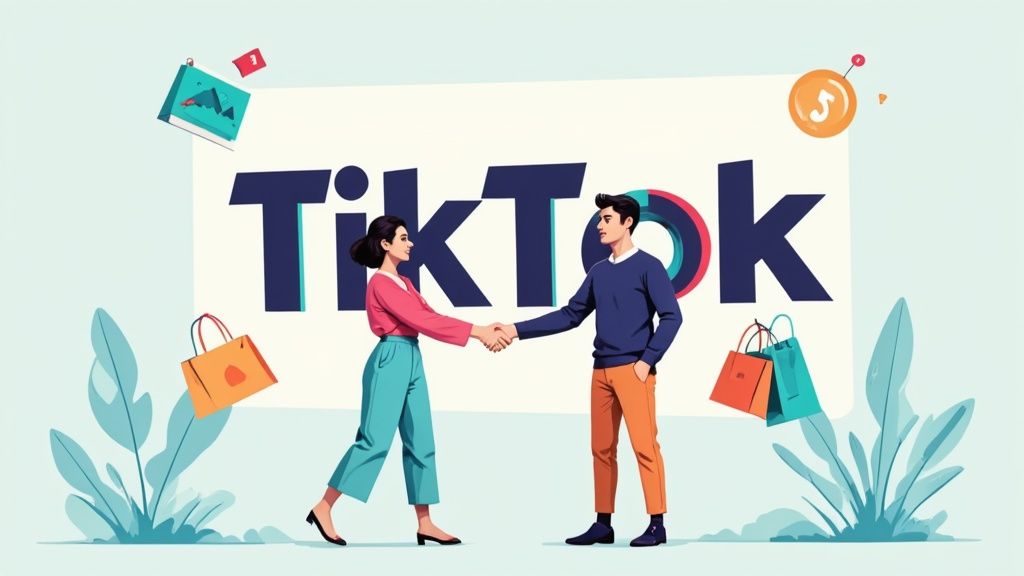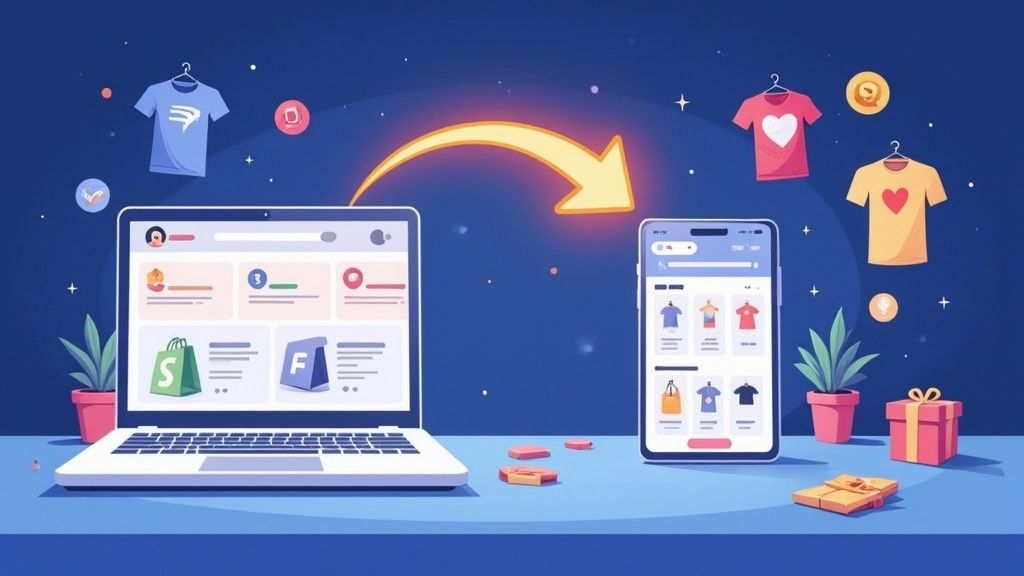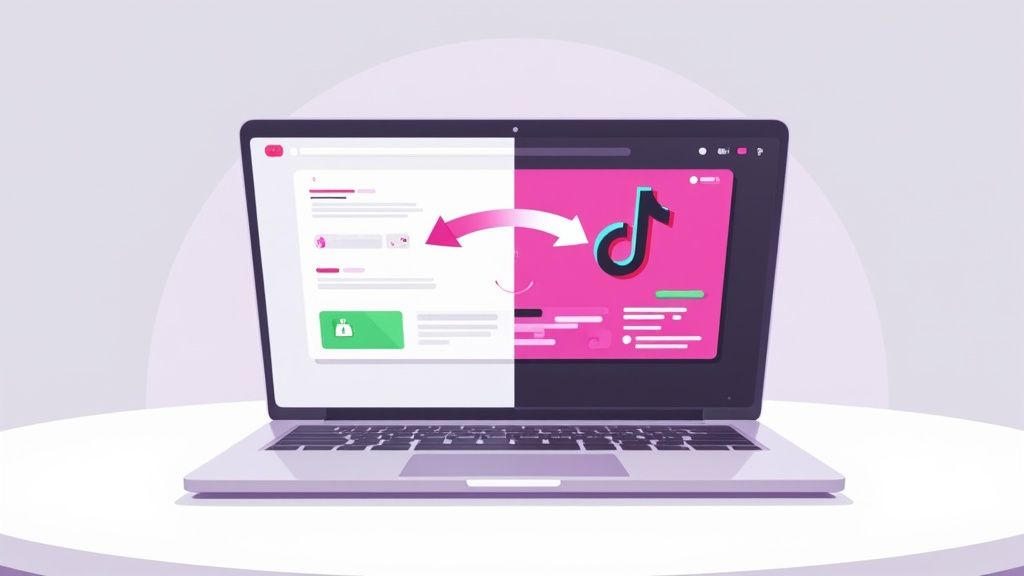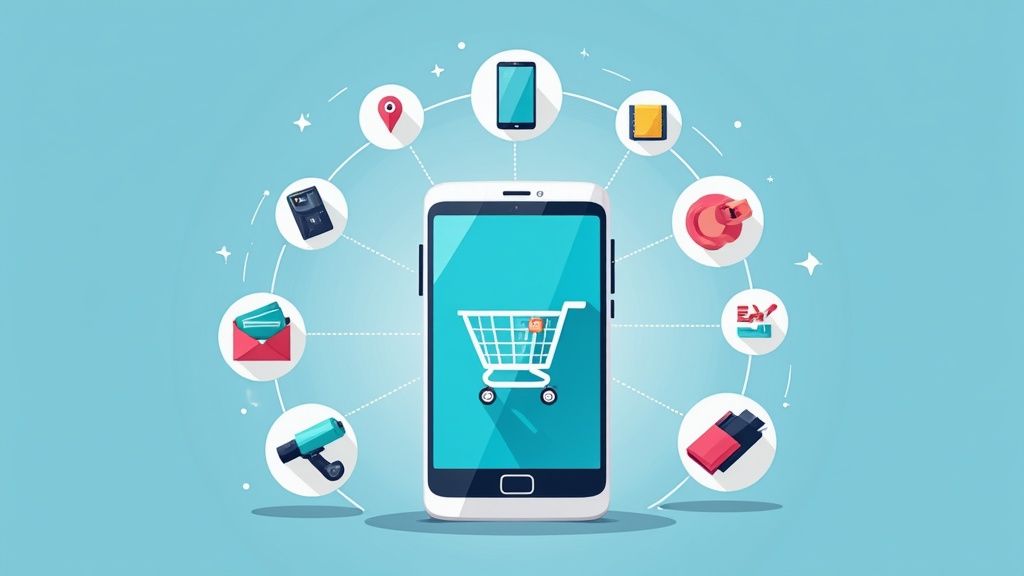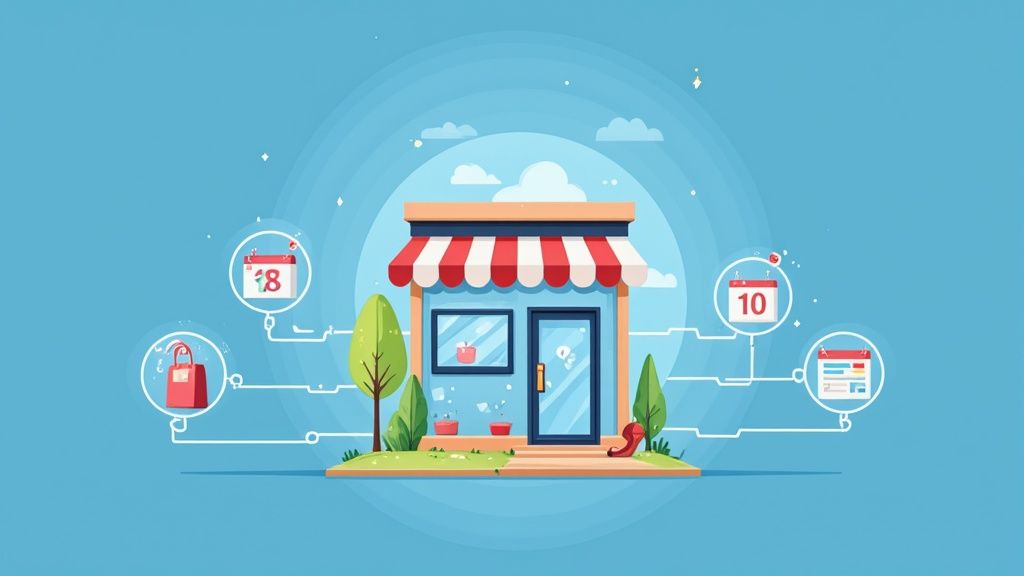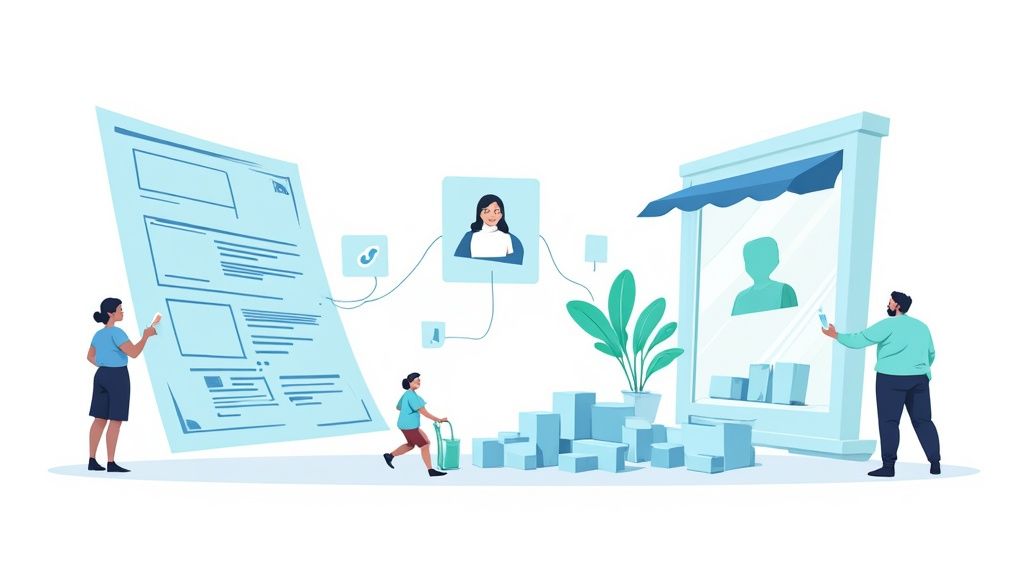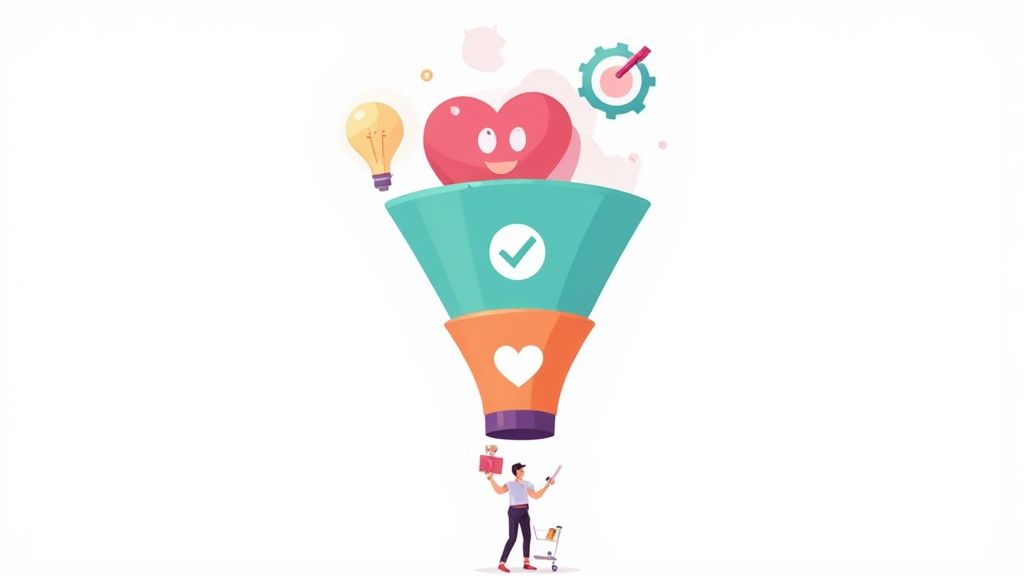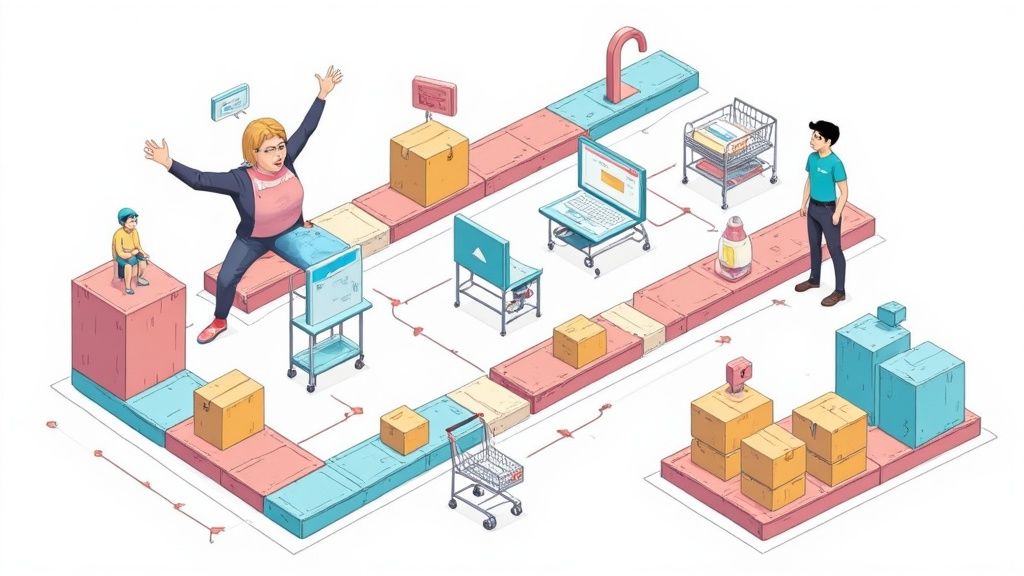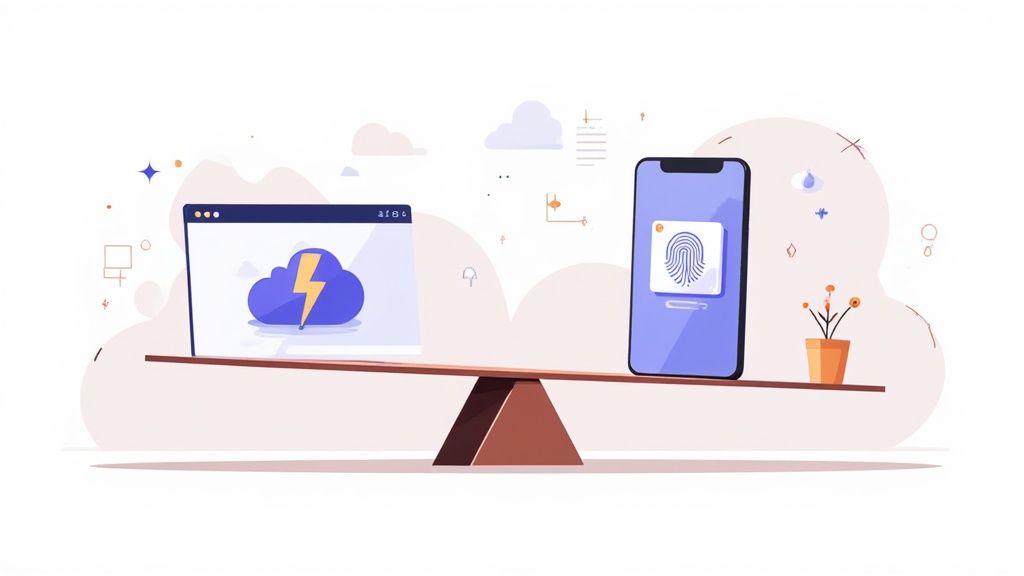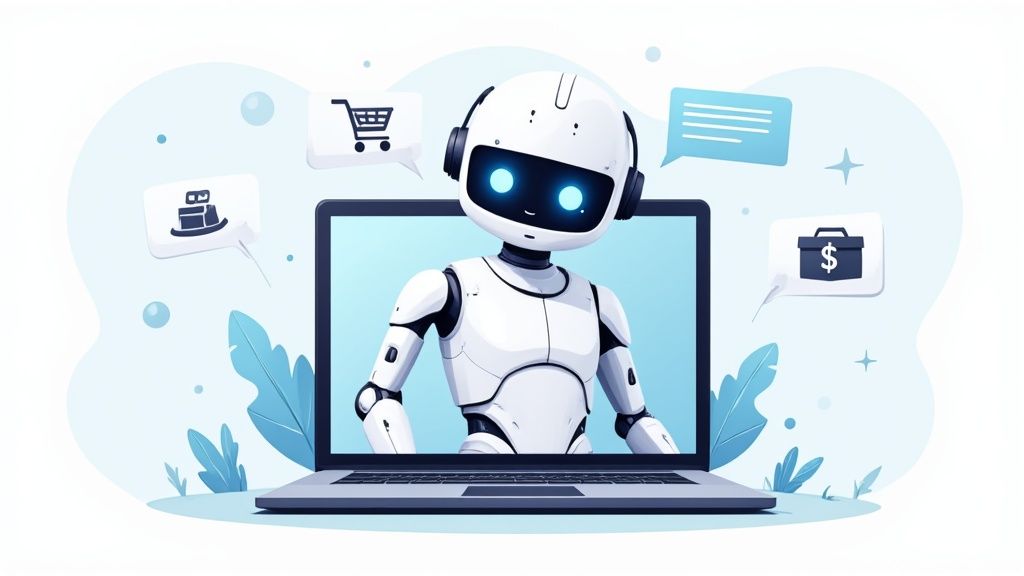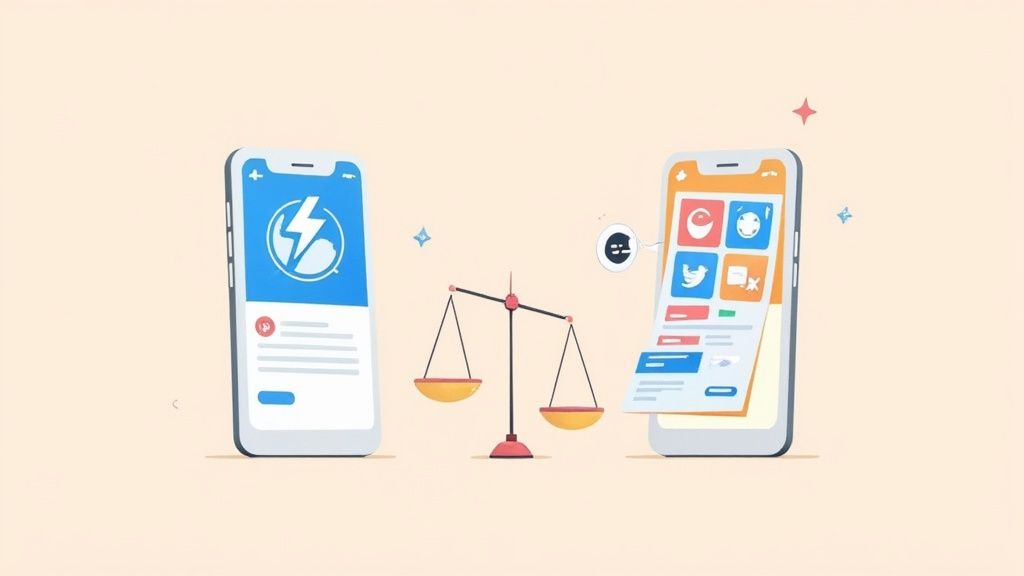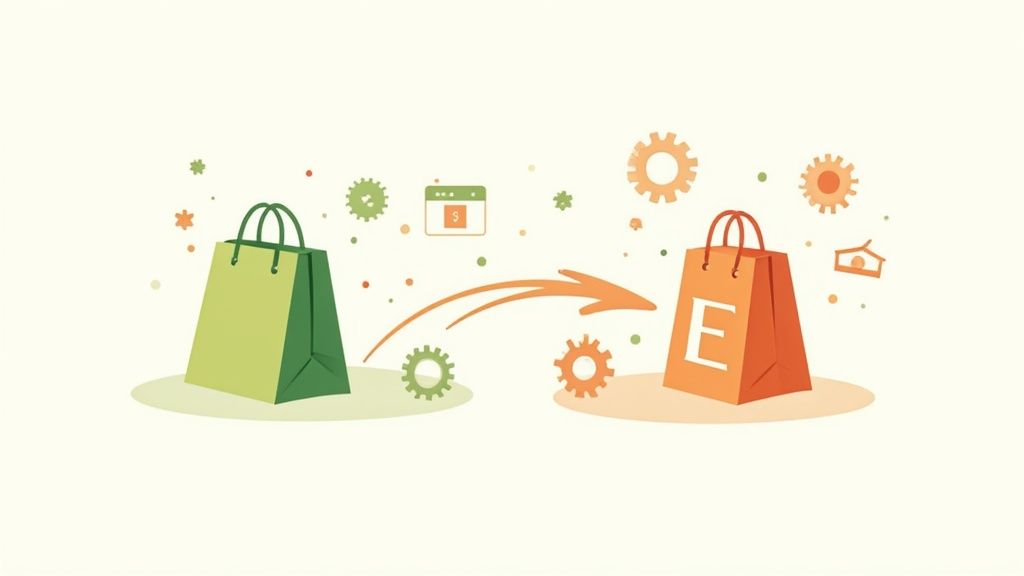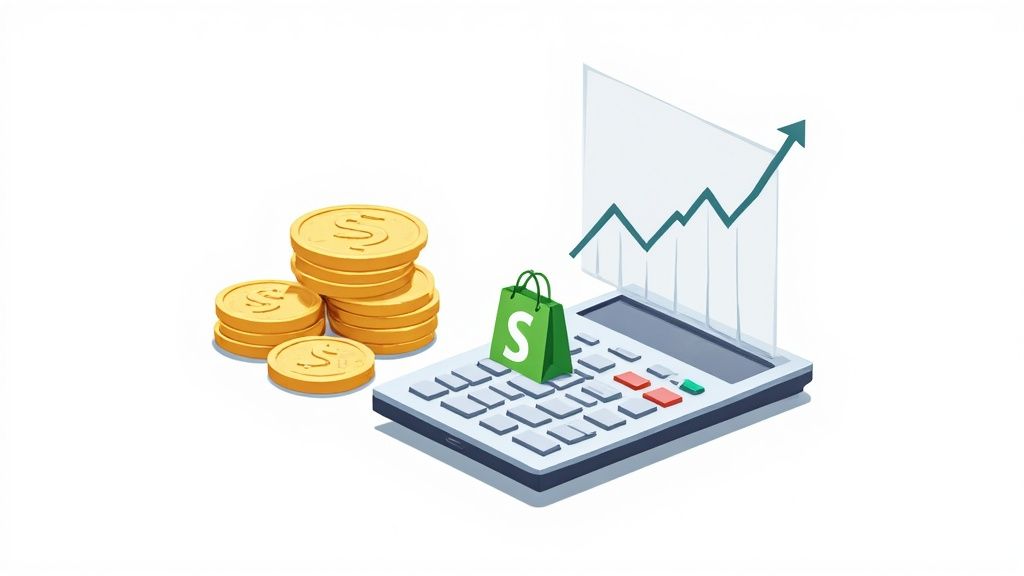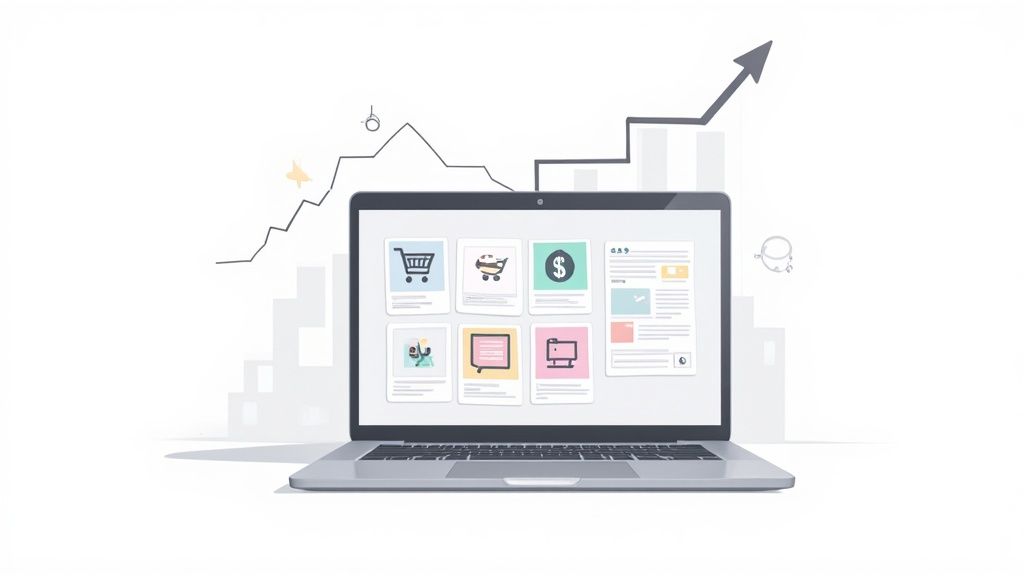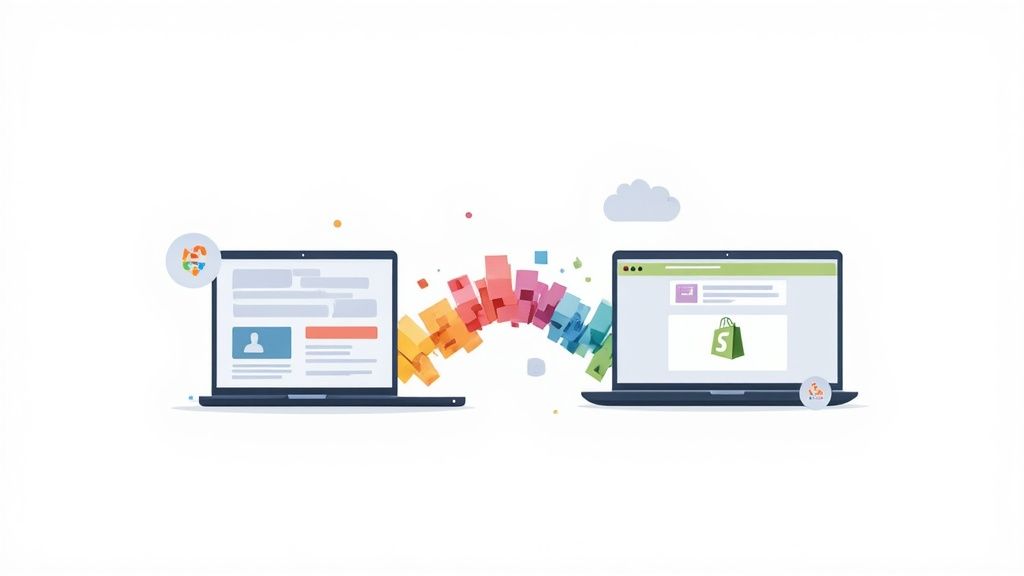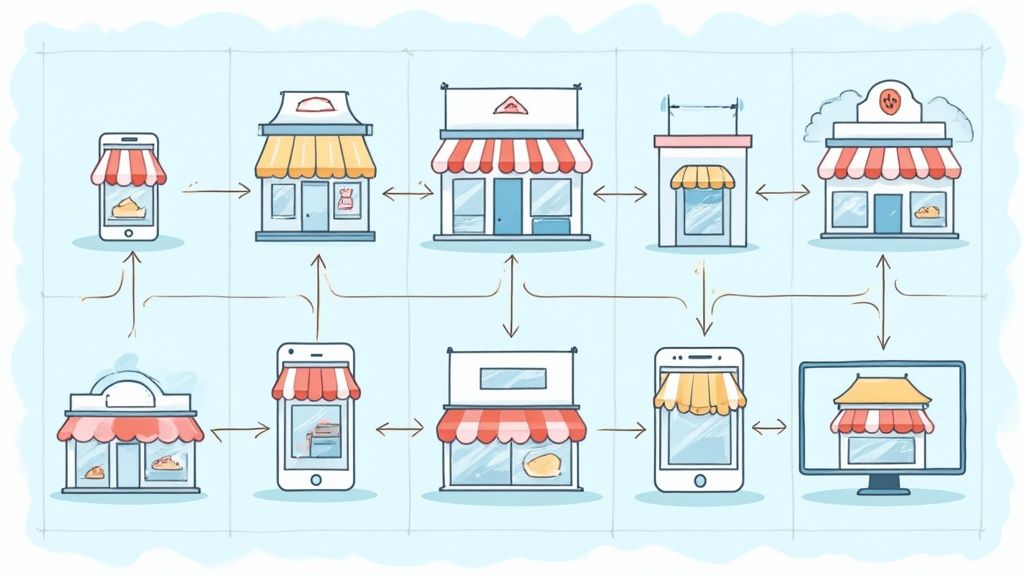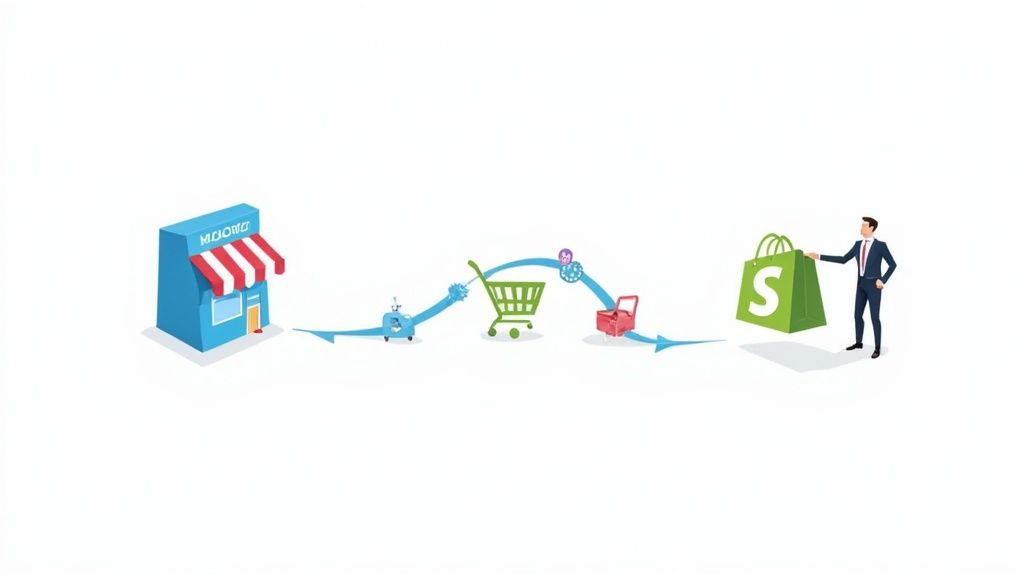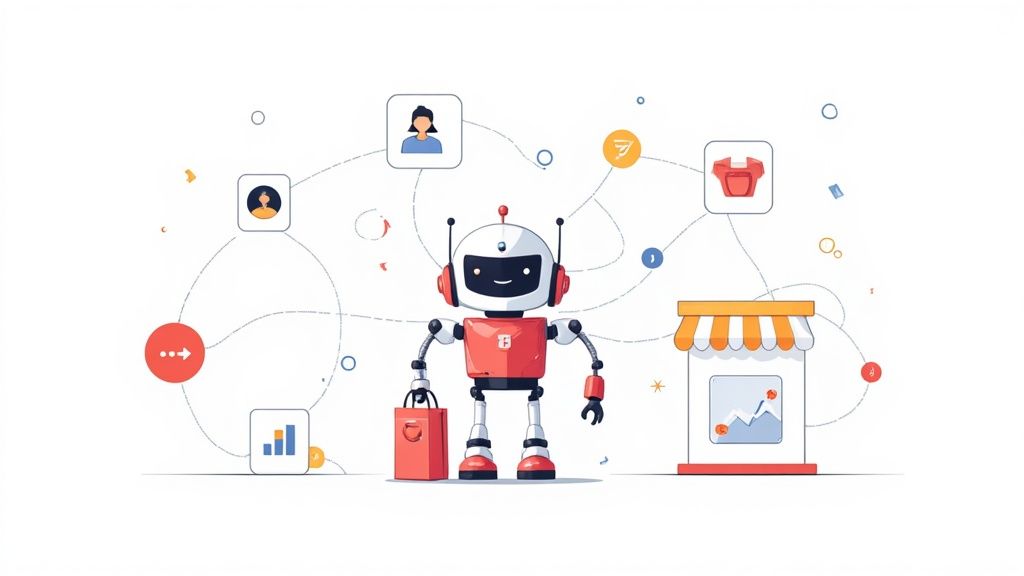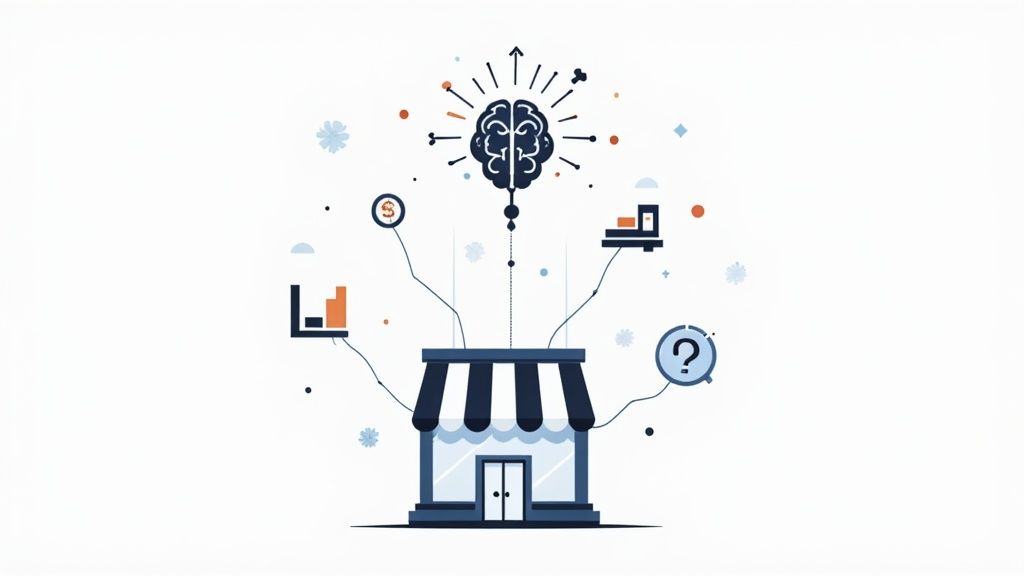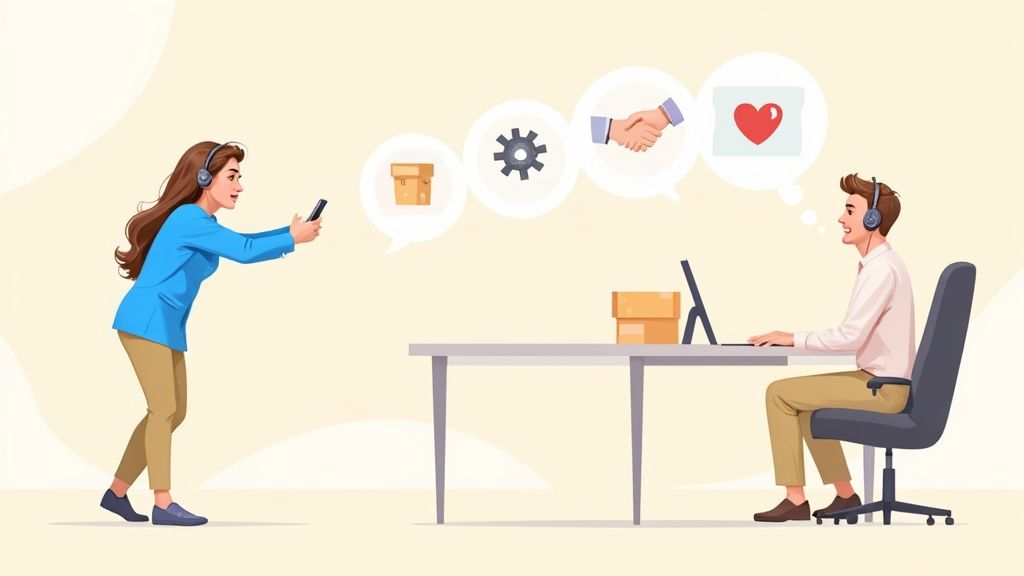
Imagine having your best salesperson on the clock 24/7. Someone who can greet every single visitor, answer every question instantly, and never gets tired. That's no longer a fantasy—it's the reality of modern AI chatbots for ecommerce. They're the tireless digital team members dedicated to turning casual browsers into loyal customers.
The New Digital Salesperson on Your Team
Every online store owner knows the sting of a lost sale. It’s a familiar story: a potential customer finds a product they love, adds it to their cart, and heads to checkout. But then, a small, unanswered question pops into their head. "Does this come in other colors?" or "What's your return policy?" With no one around to give them a quick answer, they hesitate. Then they get distracted. And just like that, they're gone—another abandoned cart.
Now, let's replay that scene, but with an AI chatbot on your site. The second that shopper pauses on the product page, a friendly chat window appears. The bot instantly clarifies the return policy and even pulls up the other available colors. The customer's doubt vanishes, their confidence is restored, and they click "buy." This is the real magic of AI chatbots for ecommerce: they smooth over the friction points in the buying journey, in real-time.
More Than Just Answering Questions
But these tools are much more than just a fancy FAQ page. We've moved past the era of clunky, robotic chat scripts. Today's AI chatbots are proactive assistants that are a fundamental part of any serious growth strategy.
- Driving Growth: They don't just wait for questions. They can jump in at critical moments to offer a timely discount code, suggest a product that perfectly complements what's in the cart, or gently guide a confused shopper through the final steps of checkout.
- Personalizing the Experience: A smart chatbot can recognize a returning customer, greet them by name, and make recommendations based on what they've looked at before. It makes the entire shopping trip feel less like a transaction and more like a personal consultation.
- Boosting Customer Satisfaction: Instant, 24/7 support means your customers are never left hanging. In fact, studies show that 40% of users don't care if they're talking to a human or a bot, as long as they get the help they need right away.
By fielding all the routine inquiries around the clock, AI chatbots free up your human support team. This lets your people focus on the complex, high-value customer situations where their expertise and empathy can truly shine.
At the end of the day, adding an AI chatbot to your store is about building a more efficient, responsive, and customer-focused business. They are your new digital salespeople—always on, always helpful, and always working to improve your bottom line. In this guide, we'll dive deep into the strategies, best practices, and real-world examples you need to put them to work for you.
How AI Chatbots Understand and Help Your Customers
To really get why AI chatbots for ecommerce are such a game-changer, you have to look under the hood. Don't worry, we're not talking about complex engineering diagrams. It’s more about understanding the "brain" that powers these conversations.
Think of it this way: a basic, old-school chatbot is like a rigid phone tree. You know the one—"Press 1 for order status, Press 2 for returns." It forces customers down a pre-set path and only understands very specific commands. An AI chatbot, on the other hand, is like a seasoned sales associate who's seen it all. It gets the nuances, understands slang or typos, and learns from every single interaction.
This advanced capability isn't magic. It's built on two core technologies: Natural Language Processing (NLP) and Machine Learning (ML). Together, they turn a simple script into a dynamic, helpful conversation that can genuinely drive your business forward.
The Power of Understanding Language
Natural Language Processing, or NLP, is what gives the chatbot its ears. It's the technology that deciphers human language, allowing a customer to casually ask, "hey where is my order?" instead of being forced to find and click a specific "Order Status" button.
NLP works by breaking down customer queries into meaningful parts to figure out their true intent. It’s smart enough to recognize that "track my package," "delivery update," and "when will my stuff get here?" all mean the exact same thing. This allows the chatbot to give the right answer, even when the question isn't phrased perfectly. It's the difference between a tool that needs precise instructions and one that just gets what you need.
This infographic shows how these advanced capabilities translate into direct business benefits like higher conversions and faster support.

As you can see, the impact goes way beyond just answering questions; it directly affects the key performance indicators that matter most to your ecommerce store.
The Ability to Learn and Improve
If NLP is the chatbot's ability to understand, then Machine Learning (ML) is its ability to learn and get smarter over time. Every single conversation your chatbot has becomes a learning opportunity.
ML algorithms analyze conversation data—which answers solved problems, which ones fell flat, and what new questions are popping up. Over time, the chatbot uses this data to refine its responses, improve its accuracy, and even learn to handle entirely new queries it wasn't initially trained on.
An AI chatbot doesn't just come pre-programmed; it evolves with your business and your customers. The more it interacts, the better it becomes at serving your audience, making it an asset that grows in value over time.
This continuous improvement cycle is what truly sets AI chatbots apart. It ensures they stay relevant and effective, adapting to new products, promotions, and customer concerns without you needing to manually update them all the time.
Comparing Chatbot Technologies
It’s important to remember that not all chatbots are created equal. The difference between a simple, rule-based system and a sophisticated, AI-powered one is night and day, especially for an e-commerce business. A rule-based bot can handle basic FAQs, but an AI chatbot can manage complex, multi-step customer journeys that lead to a sale.
To make it clearer, let's break down the key differences.
Comparing Rule-Based vs AI-Powered Chatbots
Ultimately, a basic bot acts as a digital signpost. It can point people in the right direction, but that’s about it. An AI chatbot for ecommerce serves as an active guide. It doesn't just point the way; it walks alongside your customers, answering their questions, providing personalized suggestions, and ensuring they have a smooth journey all the way from browsing to buying.
The Real Business Impact of Using AI Chatbots
It’s one thing to understand the tech behind AI chatbots for ecommerce, but what really matters is how that technology translates into real dollars and cents for your business. How does a little chat window on your site actually move the needle on your bottom line? The impact is surprisingly direct, and it stretches across the entire customer experience, from their first click to their post-purchase check-in.
Think about the most common ways online stores leak money: shoppers who can’t make up their minds, questions that go unanswered, and of course, the dreaded abandoned cart. An AI chatbot is like having a dedicated employee on the floor, ready to plug those leaks and turn potential losses into definite wins.
Boosting Sales and Recovering Revenue
One of the most powerful things a chatbot can do is jump in and actively drive sales. Picture this: a shopper has been staring at a product page for a few minutes. They're clearly interested, but something is holding them back. Instead of just letting them click away, a smart chatbot can step in.
Example Scenario:A visitor is looking at a high-end coffee machine. After two minutes of no activity, the chatbot pops up with a friendly message: "Hey there! I see you're checking out the Barista Pro. Did you know it comes with a two-year warranty? I can also offer you a 10% discount to help you decide."
This isn't a pushy, hard-sell tactic. It's a helpful nudge that can easily turn a window shopper into a paying customer, directly saving a sale you might have otherwise lost. This isn't just a hypothetical, either; it's one of the core strategies to increase website conversions that chatbots execute perfectly. They aren't just sitting there—they're an active part of your sales team.
The proof is in the numbers. Reports show that retail chatbots can boost sales conversion rates by as much as 67%. That’s a massive lift, and it really shows how effective they are at guiding shoppers over the finish line.
Delivering Flawless 24/7 Support
Great customer service doesn't clock out at 5 PM anymore. Your customers shop at all hours, and when they have a question, they want an answer now. Staffing a human support team around the clock is wildly expensive and, for most businesses, just not practical. This is where AI chatbots for ecommerce provide incredible value.
Imagine a customer placed an order late last week. They wake up at 2 AM on a Tuesday wondering where it is. Instead of firing off an email and waiting for business hours, they can just ask your chatbot.
The chatbot, tied into your store's backend, can instantly pull up their tracking number and give them a direct link. Just like that, the customer's anxiety is gone, they're happy, and your support team doesn't have another "Where's my order?" ticket waiting for them in the morning. This frees up your human agents to tackle the more complex, high-touch issues that really need a person's expertise.
Enhancing Personalization at Scale
True personalization is so much more than just sticking a customer's first name in an email. It's about understanding what they're doing on your site right now and giving them what they need before they even ask. AI chatbots are masters at this, using real-time data to create shopping experiences that feel tailor-made. By learning how to use AI in ecommerce, you can make every visitor feel like you've rolled out the red carpet just for them.
Here's a simple, everyday example. A customer adds a new digital camera to their cart. The chatbot, seeing this, can make a smart, relevant suggestion.
- Chatbot: "That's a great choice! To get the most out of your new camera, I recommend this high-speed memory card. Customers who bought this camera often purchase them together. Would you like to add it to your cart?"
This kind of intelligent upselling feels helpful, not annoying. It drives up your average order value (AOV) while actually making the customer's life easier. It's this level of smart personalization that’s becoming a huge driver of success in modern retail. In fact, a staggering 80% of online retailers have already woven AI into their operations, and it’s paying off big time—AI-powered personalization has been shown to boost revenue by up to 40%.
Essential Features Your Ecommerce Chatbot Needs

Here's the thing: not all chatbots are created equal. As you start looking at adding one to your store, you have to cut through the marketing noise and zero in on the features that actually move the needle. This isn't just about sticking a chat widget on your site; it's about adding a genuine sales and support asset to your team.
Think of it like hiring a new employee. You wouldn't bring a salesperson on board without making sure they can actually talk to customers and close deals. Your chatbot needs a specific skill set to deliver real value. These are the non-negotiables that every AI chatbot for ecommerce must have to make a tangible difference to your bottom line and your customer relationships.
Proactive Engagement and Messaging
A top-tier chatbot doesn’t just sit around waiting for someone to ask a question. It jumps into action, engaging shoppers at just the right moment—kind of like a sharp store associate who spots a customer looking a little lost. This is what we call proactive messaging.
Imagine a visitor has been scrolling through a product page for a minute or so. Instead of letting them drift away, the chatbot can pop up and initiate a conversation. It might offer a bit more information, flash a great customer review, or mention a limited-time deal. That simple move can be the difference between a bounced visitor and a sale. It’s the digital version of a friendly, "Can I help you find anything?"
Seamless Live Chat Handover
Let's be real, even the smartest AI can't solve every single problem. Some situations just need a human touch, whether it's a tricky complaint or a very specific question before a big purchase. This is where a smooth live chat handover is absolutely critical.
Your chatbot has to be smart enough to know its own limits. When a query gets too complex, it needs to intelligently transfer the entire conversation—chat history and all—to one of your human agents.
The whole point is to make the transition so smooth the customer barely notices. They should never have to repeat themselves. A clean handover keeps the experience positive and shows you respect your customer's time, blending the bot's instant availability with your team's expert touch.
This feature is your safety net. It guarantees that even the most complex customer issues are handled with care, turning a moment of potential frustration into a support win.
Deep Ecommerce Platform Integration
For a chatbot to be anything more than a glorified FAQ, it needs to be wired directly into the brain of your store. This means it needs rock-solid integrations with your main ecommerce platform (like Shopify or BigCommerce), your Customer Relationship Management (CRM) software, and your inventory system.
Without these connections, your chatbot is operating with one hand tied behind its back. With them, it becomes a true powerhouse.
- Order Tracking: A customer can ask, "Where is my package?" and the bot can instantly pull up live tracking info from your shipping system. No more manual lookups.
- Inventory Checks: It can give an immediate, accurate answer if a certain size or color is in stock, preventing the frustration of a sold-out item.
- Personalized Recommendations: By tapping into a customer’s purchase history via your CRM, the bot can suggest products they'll actually be interested in.
This deep integration elevates the chatbot from a simple Q&A tool to a genuinely knowledgeable assistant. It provides information that is accurate, personalized, and incredibly helpful—a must-have for any serious AI chatbot for ecommerce.
Your Guide to a Successful Chatbot Implementation

A great tool is only as good as the strategy behind it. Simply flipping the switch on an AI chatbot for ecommerce and hoping for the best won't cut it. You need a solid roadmap to turn it into a valuable asset instead of just another frustrating gadget for your customers. A successful launch comes down to careful planning, smart design, and a real commitment to making it better over time.
The most important first step? Defining clear, measurable goals. Vague targets like "improve customer service" are impossible to track and even harder to achieve. You need to get specific. Tie your goals to real business numbers that actually impact your bottom line.
Here are a few examples of what strong, measurable goals look like:
- Reduce support response time by 50% within the first quarter.
- Increase lead captures from product pages by 15% in the next 60 days.
- Decrease cart abandonment rates by 10% through proactive chat pop-ups.
- Resolve 40% of "Where is my order?" inquiries without a human getting involved.
When you set these benchmarks from day one, you have a clear picture of what success looks like. It also makes it much easier to measure your return on investment down the road.
Designing Helpful Conversational Flows
Once you know what you’re aiming for, it's time to design the conversations. The objective is to build a chatbot that feels genuinely helpful and intuitive, not like a clunky, robotic script. This means mapping out the common journeys your customers take and creating conversational flows that guide them without any friction.
A great place to start is by digging into your existing customer support tickets, emails, and live chat history. What are the top 5-10 questions people ask over and over again? These are the first conversations you should build out. Taking this data-first approach ensures your chatbot is solving real problems from the moment it goes live.
Think of yourself as a scriptwriter for the world's most helpful assistant. Every conversation needs a clear point, should anticipate what the customer might ask next, and must always offer an easy way to talk to a human if the bot gets stuck.
This focus on the user experience is everything. Remember, the goal is to make things easier for your customers, not harder. A well-designed conversation makes people feel heard and supported. For more ideas on what's possible, you can check out these chatbot use cases in ecommerce to see how top brands are putting these tools to work.
The Crucial Training and Testing Phase
Before your chatbot ever says "hello" to a real customer, it needs to go through some serious training and testing. This is where you "teach" the bot to understand your customers, your products, and your brand's voice. You’ll feed it real customer questions—typos, slang, and all—to sharpen its Natural Language Processing (NLP) skills.
The testing part should involve your own team acting like customers. Encourage them to try and break the bot. Have them ask weird questions, go down unexpected conversational paths, and test every single flow you've built. This internal feedback is priceless for catching mistakes and polishing responses before you launch.
This process is a core part of a much bigger trend. The entire AI-powered e-commerce market is blowing up, currently valued at around $8.65 billion and projected to hit a staggering $22.60 billion by 2032. This growth is all about how AI is changing the game for how retailers and consumers connect.
A Phased Rollout for a Smooth Launch
Whatever you do, don't just unleash your new chatbot on your entire website all at once. A phased, gradual rollout is the safest and smartest way to go.
- Start with a Pilot: Launch the bot on a single, high-traffic page first. Your contact page or a main product category page is a great place to start.
- Monitor and Collect Feedback: Keep a close eye on those initial chats. Most chatbot platforms have analytics that show you what's working and where conversations are going off the rails. Also, add a simple "Was this helpful?" button at the end of chats to get direct feedback.
- Iterate and Improve: Use all that data and feedback to make adjustments. Tweak the bot's answers, add new conversation flows for questions you missed, and squash any bugs you find.
- Expand Gradually: Once you’re confident in how it's performing on the pilot pages, you can start rolling it out to other parts of your site.
This step-by-step approach minimizes risk and makes sure your AI chatbot for ecommerce is a finely-tuned machine by the time your whole audience can interact with it. That's how you build a powerful asset that works for you from day one.
As powerful as today’s AI chatbots for ecommerce already are, what’s coming next is where things get really interesting. We’re moving past simple Q&A bots and into an era of genuine conversational shopping. The future isn't about just reacting to customer questions; it's about getting ahead of their needs and weaving commerce right into the flow of their daily lives.
Getting on board with chatbot technology now is the first step toward building the kind of hyper-efficient, customer-first store that will define tomorrow's retail.
The market trends are screaming this from the rooftops. The global AI chatbot market for e-commerce is on an explosive trajectory, expected to hit somewhere between $10 billion and $15 billion in 2025. Fast forward to 2029, and that number is projected to balloon to a staggering $46 to $47 billion. This isn’t just a trend; it's a clear signal that these tools are becoming non-negotiable for online stores everywhere. If you want to dig into the numbers, you can explore more about 2025 AI chatbot trends.
The Dawn of Hyper-Personalization
The next big leap is something called hyper-personalization. This isn't just about dropping a customer's first name into a message or remembering their last purchase. We're talking about AI that uses predictive analytics to figure out what a customer needs before they even know they need it. It’s about connecting the dots between different pieces of data to make suggestions that feel unbelievably on point.
Picture this: a chatbot notices a customer has been looking at hiking boots. It also sees, through a partnership with a travel site, that they just booked a trip to a cold-weather spot. The bot could then proactively recommend insulated, waterproof socks or thermal base layers. This isn’t just a lazy upsell; it’s providing real, context-aware value that makes the whole experience feel less like a transaction and more like a personal consultation.
Hyper-personalization is the difference between a bot saying, "People who bought this also bought..." and a bot saying, "I see you have a trip planned next month. Here’s a travel-sized version of the face wash you love."
That’s the kind of service that builds incredible brand loyalty. It shows you don't just understand a customer's shopping cart—you understand their life.
Voice Commerce and Ambient Shopping
The way we interact with tech is also changing, and voice is quickly becoming a go-to interface. Millions of us already have smart speakers and voice assistants in our homes, creating a massive new playground for what’s called voice commerce.
Soon, customers will be able to shop without ever touching a screen. Someone making dinner could just say, "Hey, order me another bottle of that olive oil I bought last month," and the purchase is done. This is ambient shopping—commerce that melts into the background of our lives, ready when we need it.
The AI chatbots we’re putting on websites today are the engines that will drive these voice commands. Their ability to understand natural language and plug into inventory and payment systems is the perfect groundwork for this hands-free future. By getting ready for this shift, your brand can be there for your customers wherever they are, making buying from you as simple as saying a few words.
Thinking this far ahead puts your business on the cutting edge. Embracing AI chatbots for ecommerce isn’t just about fixing today’s problems; it’s about laying the foundation for the next generation of how people shop.
Frequently Asked Questions About Ecommerce Chatbots
Deciding to bring a new piece of tech into your store is a big move. As promising as AI chatbots for ecommerce are, it's completely normal to have a few questions before you commit. We've been there.
To help you out, we’ve gathered some of the most common questions we hear from store owners. Here are some clear, straight-up answers to help you feel confident about your decision.
Are AI Chatbots Too Expensive for a Small Business?
Not anymore. While there are definitely some heavy-duty, enterprise-level solutions out there with price tags to match, the game has changed. Today, you’ll find plenty of platforms offering affordable, scalable plans built specifically with small businesses in mind.
You can usually start with a basic plan and then upgrade as your store grows and you need more power. The real trick is to think about the return on investment (ROI). If an affordable bot can save just a few abandoned carts a month or take some of the repetitive questions off your support team's plate, it often pays for itself in no time.
Will a Chatbot Make My Brand Feel Impersonal?
That’s a fair question, and it’s one we hear a lot. A poorly implemented bot can feel robotic, but a well-designed AI chatbot actually does the opposite—it makes your brand feel more personal.
Think about it this way: by instantly handling the simple, repetitive stuff like "Where is my order?", the bot frees up your human team. They can then focus their energy on the more complex, high-value conversations where their expertise and human touch really shine.
A great chatbot strategy isn't about replacing people; it's about blending the bot's 24/7 efficiency with your team's unique human skills. In fact, research shows that 87% of customers find chatbots effective for resolving their issues, proving that what they really value is speed and availability.
On top of that, these bots can use customer data to offer tailored product recommendations and greet returning shoppers by name. That's a far more personal touch than a generic, one-size-fits-all website can offer.
How Hard Is It to Integrate a Chatbot with Shopify?
It’s probably a lot easier than you think. The top AI chatbots for ecommerce are designed from the ground up to integrate smoothly with major platforms like Shopify, WooCommerce, and BigCommerce.
For most store owners, getting set up is a straightforward, no-code process. It's usually as simple as finding the app in your platform's app store and clicking "install."
And for businesses with more unique or complex needs? The chatbot providers almost always have extensive documentation and dedicated support teams ready to walk you through it. They want you to succeed, so they make sure you have the help you need for a smooth launch.
How Can I Measure My Chatbot's ROI?
Measuring your bot's success all comes back to the goals you set before you even launched it. To see its direct impact, you have to track the right key performance indicators (KPIs).
Here are the key metrics you’ll want to keep an eye on:
- Chatbot Conversion Rate: What percentage of conversations that start with the bot end in a sale?
- Support Ticket Deflection: How many routine questions does the bot handle on its own, without a human agent needing to step in?
- Cart Abandonment Reduction: Did your store’s cart abandonment rate go down after the bot went live?
- Customer Satisfaction (CSAT): What are the scores from post-chat surveys? This tells you how happy customers are with the support they got.
The good news is that most chatbot platforms come with a built-in analytics dashboard. This makes it incredibly easy to track these numbers and prove your chatbot's value to your bottom line.
At ECORN, we specialize in implementing advanced solutions like AI chatbots to help Shopify stores grow. We integrate powerful tools that enhance your customer experience and boost your conversion rates. Discover how our Shopify expertise can elevate your brand.






